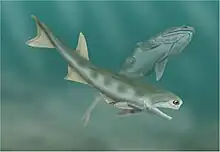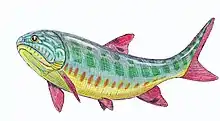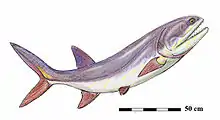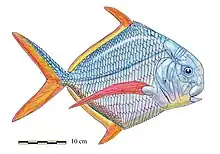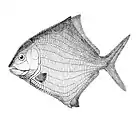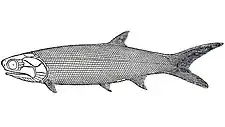Brachydegma
Brachydegma is an extinct genus of prehistoric ray-finned fish that lived during the Leonardian age (Cisuralian/lower Permian) in what is now Texas, United States. It is known from two fossils, which were recovered from the Clear Fork Formation. It is one of the only fossil ray-finned fish from the Permian that preserves the skull bones in three dimensions.[2]
| Brachydegma Temporal range: Leonardian | |
|---|---|
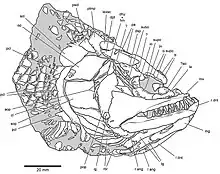 | |
| Interpretive drawing of the skull of the holotype of Brachydegma caelatum[2] | |
| Scientific classification | |
| Kingdom: | |
| Phylum: | |
| Class: | |
| Family: | |
| Genus: | †Brachydegma Dunkle, 1939 |
| Binomial name | |
| †Brachydegma caelatum Dunkle, 1939 | |
Classification
Brachydegma was first considered a "palaeoniscid".[3] A later study rather suggested that Brachydegma could be one of the earliest crown neopterygians (Halecomorphi) known from the fossil record.[4] However, this view relied on misinterpretations of cranial features. A more recent study yielded conflicting placements of Brachydegma on the actinopterygian tree of life, rendering its placement in an order or family difficult. It appears to be closely related or possibly a member of the crown group of Actinopterygii, though a closer relationship with either Neopterygii or Polypteriformes appears plausible.[2]
References
- "†Brachydegma Dunkle 1939 (ray-finned fish". Fossilworks.
- Argyriou, Thodoris; Giles, Sam; Friedman, Matt (2022). "A Permian fish reveals widespread distribution of neopterygian-like jaw suspension". eLife. 11: e584334. doi:10.7554/eLife.58433. PMC 9345605. PMID 35579418.
- Dunkle, David H. (1939). "A new palaeoniscid fish from the Texas Permian". American Journal of Science. 237 (4): 262–274. Bibcode:1939AmJS..237..262D. doi:10.2475/ajs.237.4.262.
- Hurley, Imogen A.; Mueller, Rachael Lockridge; Dunn, Katherine A.; Schmidt, Eric J.; Friedman, Matt; Ho, Robert K.; Prince, Victoria E.; Yang, Ziheng; Thomas, Mark G.; Coates, Michael I. (2006). "A new time-scale for ray-finned fish evolution". Proceedings of the Royal Society B. 274 (1609): 489–498. doi:10.1098/rspb.2006.3749. PMC 1766393. PMID 17476768.
